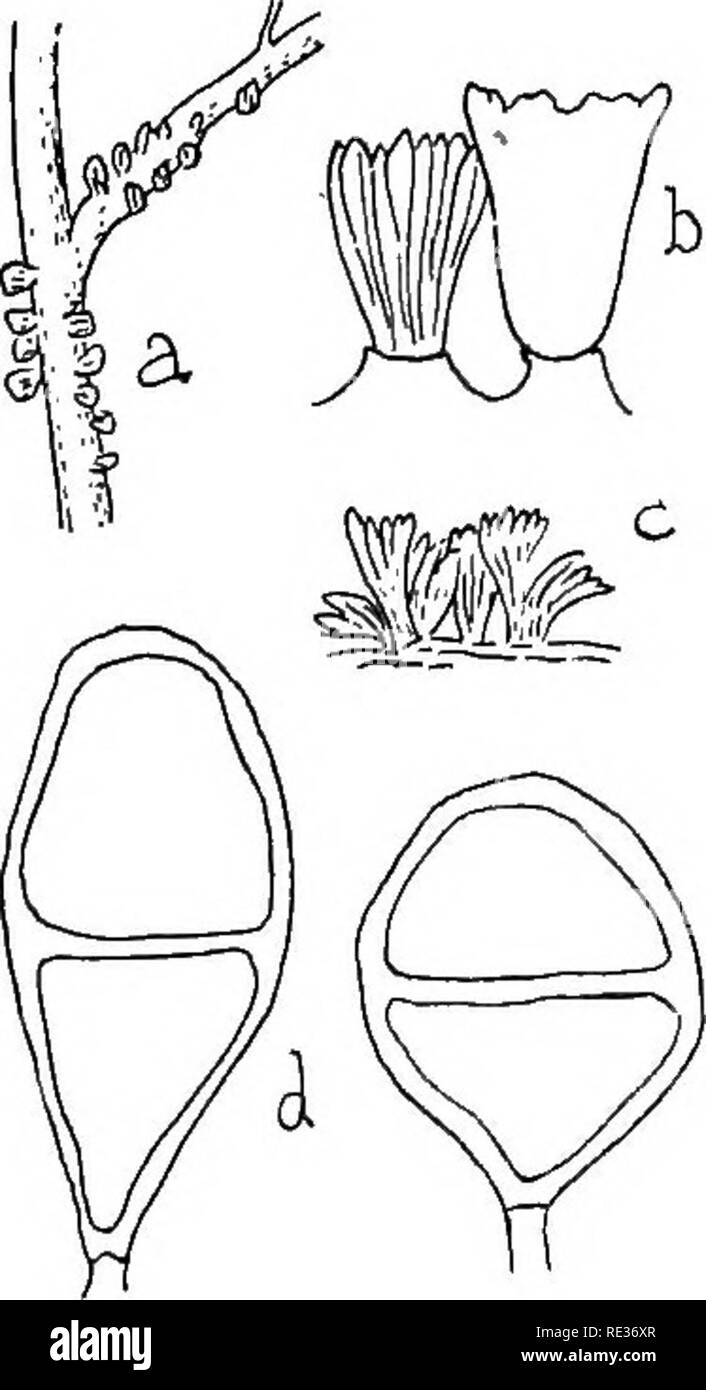. The British rust fungi (Uredinales) their biology and classification. Rust fungi. GYMNOSPOEANGIUM 307 ^cidia on leaves, branches and fruits of Crataegus Oxy- acantha, C. monogyna, Mespilus ger- manica, Gydonia vulgaris, June— August; teleutospores on Juniperus Sabina, April and May; uncommon. (Fig. 232.) The course of the life history of this species is identical with that of the pre- ceding. It is distinguished by its shorter and broader teleutospores, which resemble those of 6. Sahinae, but the aecidia are quite different from those of that species and resemble those of 0. clavariaeforme..

Image details
Contributor:
The Book Worm / Alamy Stock PhotoImage ID:
RE36XRFile size:
7.1 MB (195.7 KB Compressed download)Releases:
Model - no | Property - noDo I need a release?Dimensions:
1165 x 2144 px | 19.7 x 36.3 cm | 7.8 x 14.3 inches | 150dpiMore information:
This image is a public domain image, which means either that copyright has expired in the image or the copyright holder has waived their copyright. Alamy charges you a fee for access to the high resolution copy of the image.
This image could have imperfections as it’s either historical or reportage.
. The British rust fungi (Uredinales) their biology and classification. Rust fungi. GYMNOSPOEANGIUM 307 ^cidia on leaves, branches and fruits of Crataegus Oxy- acantha, C. monogyna, Mespilus ger- manica, Gydonia vulgaris, June— August; teleutospores on Juniperus Sabina, April and May; uncommon. (Fig. 232.) The course of the life history of this species is identical with that of the pre- ceding. It is distinguished by its shorter and broader teleutospores, which resemble those of 6. Sahinae, but the aecidia are quite different from those of that species and resemble those of 0. clavariaeforme.. The secidia of O. confusum are reported also doubtfully on Pyrus communis and Cotoneaster integerrimus. The cells of the peridium have their side-walls marked with elongated obliquely placed ridge.s, while those of G. clavariaeforme have tliem coarsely warted. This description is taken from Fischer and Plowright, both of whom give long accounts of its peculiarities. In all Plowright's specimens of O. confusum (produced artificially on Hawthorn, Quince, Medlar) the peridia were smaller, shorter, less deeply torn, and rather more inflated than those of O. clavariae forme, i.e. of the typical R. lacerata. Distribution : Europe, Northern Persia.. Fig. 232. G. confusum. a, cluster of secidia on Haw- thorn twig, nat. size; 6, two peridia of same x 10; c, clus- ter of secidia on Quince leaf, X 5 ; (J, two teleutospores on J. Sabina x 600. AH from ciiltures by Plowright. 3. Gymnosporangium Juniperi Link. Tremella juniperina L. Sp. PI. p. 1625. Roestelia cornuta Tul.; Cooke, Handb. p. 534, f 218; Micr. Fung. p. 193, pl. 2, f. 18, 19. Oymnosporangium Juniperi Link, Obs. i. 7. Cooke, Handb. p. 509, f 203 ; Micr. Fung. p. 214. Sydow, Monogr. iii. 27, f 11. 0. jimiperinum Fr. Syst. Myc. iii. 506. Plowr. Ured. p. 235. Fischer, Ured. Schweiz, p. 391, f 278. Sacc. Syll. vii. 738 p.p. G. cornutum Arthur, Mycologia, i. 240. Kern, N. Amer. Fl. vii. 198. Spermogones. Bpiphyllous, subepidermal,